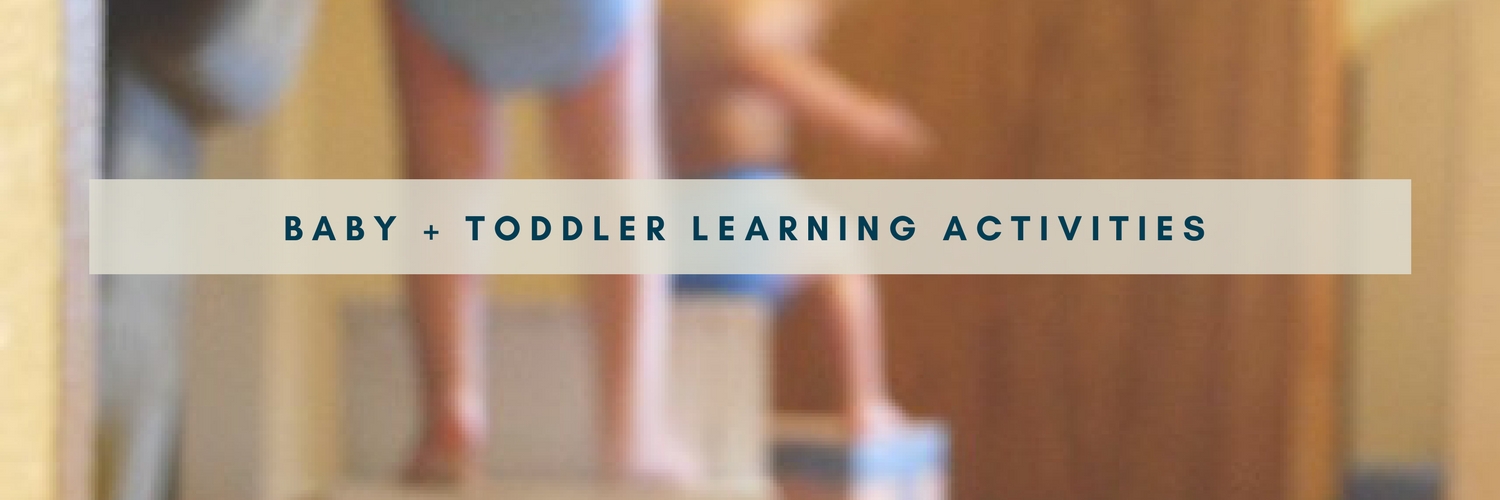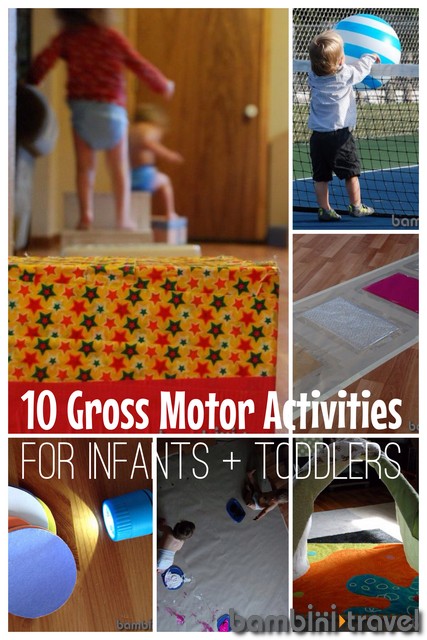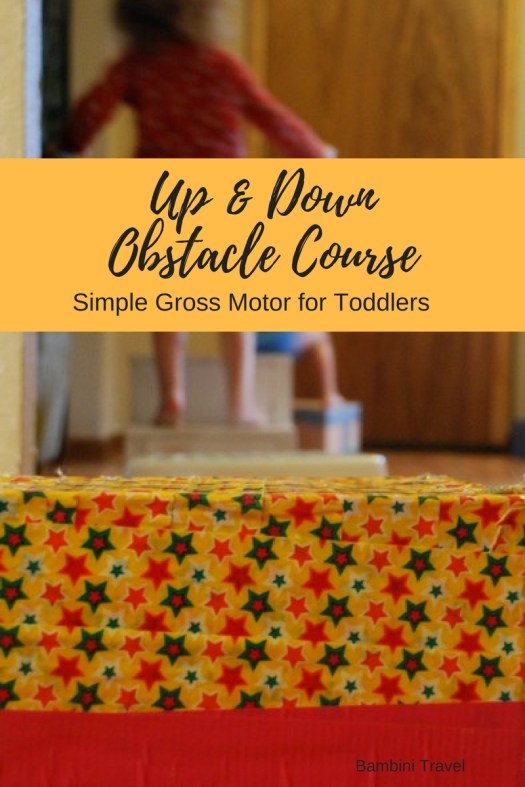10 Awesome Gross Motor Activities for Babies + Toddlers

Babies and Toddlers are active little ones that are in constant search of ways to practice and develop their Gross Motor skills. I don’t think we often think of learning to crawl or balance or walk as curriculum, but for babies and younger toddlers this is what they are learning.
This is what they are interested in right now.
When my twins were in this crawling, cruising, starting to walk phase they wanted to be constantly in motion. This can be crazy making, but if you give them some activities to do that target these developing gross motor skills you will have happy and eventually tuckered out (yay nap time!) little ones.

Here are 10 of our favorite ways to move little bodies while you learn, create, and have fun.
affiliate links are included below. thanks for your support!
10 Gross Motor Activities for Infants and Toddlers
1. Big Paper Paint
One of the things I love most about Children’s Museums is the opportunity for large scale art. They have the space and materials to scale an entire wall with art. To have a cooperative mural covering a large table. To have a large weaving experience. To have an easel big enough for several children to create.
Inspired by these experiences, this is one of my favorite activities to do at home with older infants and young toddlers. This is a great activity for babies that encourages crawling or early walking while you paint.
Materials:
- Large Pieces of Paper
- Tape
- Paint
- Plate or Tray for Paint
Set Up:
Cover your floor in paper – the bigger the better.
Clear the general area around the paper.
Pour paint onto a tray or plate.
Activity:
I suggest striping your child down to their diaper and then offer them trays of different colored paint. I placed the trays in a couple different places around the paper to encourage them to crawl.
Allow them to crawl, walk, and paint everywhere on the paper and themselves. This is obviously messy – but the large scale of the painting gives them space to move around and explore their bodies while they paint.
Clean Up:
Remove paint trays to a counter or sink. Wash these later at your convenience.
Gate off the area if possible. This obviously makes it easier to try to clean without worrying about little ones crawling back into the area.
Either way, cleaning off your little ones is the first step. Mine went straight in the bathtub. The wonderful thing about tempera paint is how easily it washes right off.
Once your infants are cleaned off and happily situated with another activity or fast asleep, remove the paper from the floor. Save if so desired. Use a wet washcloth or wet wipe to clean any stray paint marks on the floor. Clorox wipes work well for me.
2. Texture Crawl
This was inspired by a seriously cool floor at the Children’s Museum in Madison WI. This is a quick do-it-yourself texture floor perfect for rolling and crawling babies.
Set Up:
Tape a long piece of butcher paper to the floor. Put it in a high traffic play area for your child to explore.
Cut your chosen materials down, if needed, to fit within the butcher paper. Attach your textured materials spaced out along the paper by securing all four corners with tape. Don’t be shy with the tape. The more thorough you are with this step, the better it will hold up. However, make sure you are leaving an adequate amount of the material exposed for exploration.
Activity:
Your infant(s) will likely discover this on their own – little ones tend to be naturally curious and observant of newness. As they explore the area, you can provide them with words to describe the textures they discover such as; scratchy, bumpy, shiny, smooth, etc.
3. Playmat Tunnel
Once my twins started moving, our playmat quickly became a discarded object in the corner until I had this brainstorm one afternoon. This is another fun way to utilize a playmat once your kids are on the move.
Set Up:
Cover two sides with blankets to create a tunnel.
Activity:
I sat on the opposite side to encourage my babies to crawl through. It was a short, non-intimidating tunnel so with only mild encouragement they ventured through. Place other exciting objects on the opposite side of the tunnel to encourage them to crawl back and forth. Play peekaboo around the sides.
Clean Up:
Remove the blankets when you are done with playtime. This activity should definitely be supervised at all times.
4. DIY Climbing Box
Babies love to crawl over, climb on, and push things. Instead of following them around saying “No” all day, I decided to make something that they could use. The idea to form when I watched my daughter and a diaper wipe box. For most of a day I watched her push it around and sit on it, suddenly…inspiration struck!
To Create:
1. I filled the box to the top with textbooks I will probably never read again and some newspaper both to add weight to the box and support it under my child’s weight.
2. Then I taped it shut.
3. Covered it completely with duct tape. I attempted to make it look cute – not sure I succeeded.
My kids were thrilled. It has quickly become a fun heavy-work object to push, as well as a stool. Ours held up brilliantly through 3 years and 4 moves. Our twins used them endlessly for pushing, climbing on, or as part of an obstacle course.
5. Stuffed Friend Slide
Imaginative and social play activity integrated into movement activity with toddlers. All you need is a stuffed animal (or many) and a slide. We used our backyard toddler slide.
Rolling things down the slide is a popular toddler activity. We took it a step forward and took their stuffed friends and babies for a slide. We did this in our backyard, but it could also be done at a playground.
To start, I simply asked my toddlers if they thought Baby and Monkey would like to play on the slide with them. They thought it was a fabulous idea and so we headed outside with our friends in tow.
Once at the slide, depending on your toddler’s climbing skills you may have to hold their stuffed animal while they climb the slide. Once at the top ask if they would rather send the animal down first or have it slide next to them. In our case, some social practice with turn taking also took place as they waited for each other to go down the slide.
Continue for as long as they are interested. We eventually went back in and found some more friends that wanted to slide.
6. Animal Pull
Perfect activity for older infants or younger toddlers who are thrilled with their newly discovered walking abilities. Toddlers love pushing and pulling things. This activity provides them an additional opportunity for pulling something.
Simply tie a ribbon around the neck or middle of an animal. I used a darling collection of animals from an infant floor mat that went out of use when our little guys started moving. Most stuffed animals would work, although ones with four legs balance a little better.
The first time I brought these animals out I modeled “taking an animal for a walk.” My toddlers quickly imitated me and walked their animals back and forth, back and forth across our house. Super simple but my twins played with these endless for other a week.
read also: zoo animal activities for all ages
7. Toddler Yoga
Our toddlers’ first introduction to yoga was them imitating my movements alongside my mat on a typical morning and from there we have slowly built their skills. If you think your child would enjoy moving their body in a different way, feel free to introduce them to yoga independently of any workout you may do.
Here are some tips to start simple yoga with toddlers:
- Prepare a quiet space with mats or blankets to stand on. I cut a $10 yoga mat in half and it was the perfect size for each of my twins to have their own yoga space.
- Invite them to imitate simple poses such as Tree Pose or Downward Dog.
- Having a book to follow may help engage them further. One of our favorites is “Little Yoga: A Toddler’s First Book of Yoga” by Rebecca Whitford and Martina Selway.
- Try to have fun, follow their lead, and not worry to much about them getting it “right.”
- End by teaching them to say Namaste to each other.

8. Up and Down Obstacle Course
Toddlers will working on understanding the concepts of up and down, while they practice the gross motor skill of stepping up and down.
Set Up:
Position your boxes and stools around a room to create a course.
Activity:
Have your toddler line up behind you and demonstrate the course for them with energetic “up!” and “down!” as you go over the obstacles. From there encourage them to do it again and again.
9. Finding Circles
This is a toddler activity that combines shape recognition, flashlight play, and movement.
To Prepare:
Cut out some circles with Construction Paper
Tape them around your classroom or home at varying heights and spaces.
Consider positional words when placing (up, down, under, above, etc)
Gather Flashlights – one for each child
Activity:
Invite your child to go on a Circle Hunt with you. Give each child a flashlight and ask if they can shine their light on a circle. You may have to model this the first couple of times. Use language to describe where they find the circles and/or what color circle. For example, “you found a blue one above your head” or “that circle is next to the light switch” Soon you will have kids animated and running all over crying out “I found a circle!”
10. Toddler Tennis
This is an activity for you to do at the park with your child(ren) which was inspired by some amazing toddler teachers I worked with at UMCDC. To be fair, this only very loosely represents tennis, but it is a great movement and social skills activity.
Bring a couple of large bouncy balls (soccer or other balls work too) with you to a nearby tennis court.
Show your toddler how to bounce or throw the ball over the net. Encourage them to stand on the other side and bounce it back to you. Encourage them further to bounce the ball over the net to a peer if you have other children along.
Our goal was to encourage social interaction, build gross motor skills, and have fun. There were no rules or expectations beyond that. Have fun, move around, and be silly together.